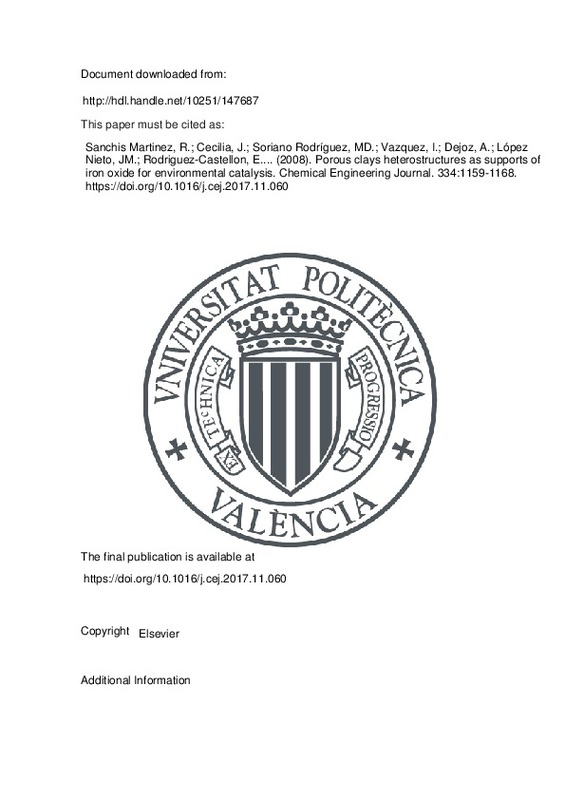JavaScript is disabled for your browser. Some features of this site may not work without it.
Buscar en RiuNet
Listar
Mi cuenta
Estadísticas
Ayuda RiuNet
Admin. UPV
Porous clays heterostructures as supports of iron oxide for environmental catalysis
Mostrar el registro sencillo del ítem
Ficheros en el ítem
| dc.contributor.author | Sanchis Martinez, Rut
|
es_ES |
| dc.contributor.author | Cecilia,J.A.
|
es_ES |
| dc.contributor.author | Soriano Rodríguez, Mª Dolores
|
es_ES |
| dc.contributor.author | Vazquez, Isabel
|
es_ES |
| dc.contributor.author | Dejoz, Ana
|
es_ES |
| dc.contributor.author | López Nieto, José Manuel
|
es_ES |
| dc.contributor.author | Rodriguez-Castellon, E.
|
es_ES |
| dc.contributor.author | Solsona Espriu, Benjamin Eduardo
|
es_ES |
| dc.date.accessioned | 2020-07-09T03:32:17Z | |
| dc.date.available | 2020-07-09T03:32:17Z | |
| dc.date.issued | 2008-12-15 | es_ES |
| dc.identifier.issn | 1385-8947 | es_ES |
| dc.identifier.uri | http://hdl.handle.net/10251/147687 | |
| dc.description.abstract | [EN] Porous Clays Heterostructures (PCH) from natural pillared clays (bentonite with a high proportion of montmorillonite) have been used as supports of iron oxide for two reactions of environmental interest: i) the elimination of toluene (a representative compound of one of the most toxic subsets of volatile organic compounds, aromatics) by total oxidation and ii) the selective oxidation of H2S to elemental sulfur. For both reactions these catalysts have resulted to be remarkably more efficient than similar catalysts prepared using conventional silica as a support. Thus, in the total oxidation of toluene it has been observed that the catalytic activity obtained using siliceous PCH is two orders of magnitude higher than that with conventional silica. The catalytic activity has shown to be dependant of the capacity of the support for dispersing iron oxide in a way that the higher the dispersion of iron oxide on the surface of the support, the higher is the activity. In the case of the selective oxidation of H2S to S both higher catalytic activity and higher selectivity to S have been observed using siliceous porous clays heterostructures than using conventional silica. Highly dispersed FeOx species have been shown as highly selective towards elemental sulfur whereas more aggregated FeOx species favour the formation of sulphur oxides decreasing the selectivity to S. Analyses of the surface by XPS have shown the predominance of sulfate species in the catalysts presenting low selectivity to elemental sulfur. | es_ES |
| dc.description.sponsorship | The authors would like to acknowledge the DGICYT in Spain (CTQ2015-68951-C3-1-R, CTQ2015-68951-C3-3-R, CTQ2012-37925-C03-2, CTQ2012-37925-C03-3 and CTQ2012-37984-C02-01) and FEDER for financial support. We also thank the University of Valencia for funding (UV-INV-AE-16-484416) and SCSIE-UV for assistance. | es_ES |
| dc.language | Inglés | es_ES |
| dc.publisher | Elsevier | es_ES |
| dc.relation.ispartof | Chemical Engineering Journal | es_ES |
| dc.rights | Reconocimiento - No comercial - Sin obra derivada (by-nc-nd) | es_ES |
| dc.subject | H2S to S | es_ES |
| dc.subject | Toluene | es_ES |
| dc.subject | Total and selective oxidation | es_ES |
| dc.subject | Iron oxide | es_ES |
| dc.subject | VOC | es_ES |
| dc.subject | Porous Clays Heterostructures (PCH) | es_ES |
| dc.title | Porous clays heterostructures as supports of iron oxide for environmental catalysis | es_ES |
| dc.type | Artículo | es_ES |
| dc.identifier.doi | 10.1016/j.cej.2017.11.060 | es_ES |
| dc.relation.projectID | info:eu-repo/grantAgreement/MINECO//CTQ2015-68951-C3-3-R/ES/TRATAMIENTOS CATALITICOS AVANZADOS PARA LA VALORIZACION DE LA BIOMASA Y LA ELIMINACION DE RESIDUOS ASOCIADOS/ | es_ES |
| dc.relation.projectID | info:eu-repo/grantAgreement/MINECO//CTQ2012-37925-C03-01/ES/CATALIZADORES PARA LA ENERGIA Y EL MEDIOAMBIENTE: ACTIVACION SELECTIVA DE ENLACES S-H Y C-H/ | es_ES |
| dc.relation.projectID | info:eu-repo/grantAgreement/MINECO//CTQ2012-37925-C03-02/ES/CATALIZADORES PARA LA ENERGIA Y EL MEDIOAMBIENTE: OPTIMIZACION DE PROCESOS CATALITICOS DE OXIDACION PARA LA OBTENCION DE HIDROGENO Y OLEFINAS Y LA ELIMINACION DE VOCS./ | es_ES |
| dc.relation.projectID | info:eu-repo/grantAgreement/MINECO//CTQ2012-37925-C03-03/ES/CATALIZADORES PARA LA ENERGIA Y EL MEDIOAMBIENTE: HIDRODESULFURACION Y HIDRODESOXIGENACION/ | es_ES |
| dc.relation.projectID | info:eu-repo/grantAgreement/MINECO//CTQ2012-37984-C02-01/ES/MEJORA CATALITICA DE LOS BIOCOMBUSTIBLES PRODUCIDOS POR PIROLISIS DE BIOMASA LIGNOCELULOSICA/ | es_ES |
| dc.relation.projectID | info:eu-repo/grantAgreement/UV//INV-AE16-484416/ | es_ES |
| dc.relation.projectID | info:eu-repo/grantAgreement/MINECO//CTQ2015-68951-C3-1-R/ES/TRATAMIENTOS CATALITICOS AVANZADOS PARA LA VALORIZACION DE LA BIOMASA Y LA ELIMINACION DE RESIDUOS ASOCIADOS/ | es_ES |
| dc.rights.accessRights | Abierto | es_ES |
| dc.contributor.affiliation | Universitat Politècnica de València. Instituto Universitario Mixto de Tecnología Química - Institut Universitari Mixt de Tecnologia Química | es_ES |
| dc.description.bibliographicCitation | Sanchis Martinez, R.; Cecilia, J.; Soriano Rodríguez, MD.; Vazquez, I.; Dejoz, A.; López Nieto, JM.; Rodriguez-Castellon, E.... (2008). Porous clays heterostructures as supports of iron oxide for environmental catalysis. Chemical Engineering Journal. 334:1159-1168. https://doi.org/10.1016/j.cej.2017.11.060 | es_ES |
| dc.description.accrualMethod | S | es_ES |
| dc.relation.publisherversion | https://doi.org/10.1016/j.cej.2017.11.060 | es_ES |
| dc.description.upvformatpinicio | 1159 | es_ES |
| dc.description.upvformatpfin | 1168 | es_ES |
| dc.type.version | info:eu-repo/semantics/publishedVersion | es_ES |
| dc.description.volume | 334 | es_ES |
| dc.relation.pasarela | S\383015 | es_ES |
| dc.contributor.funder | Universitat de València | es_ES |
| dc.contributor.funder | European Regional Development Fund | es_ES |
| dc.contributor.funder | Ministerio de Economía y Competitividad | es_ES |







![[Cerrado]](/themes/UPV/images/candado.png)

